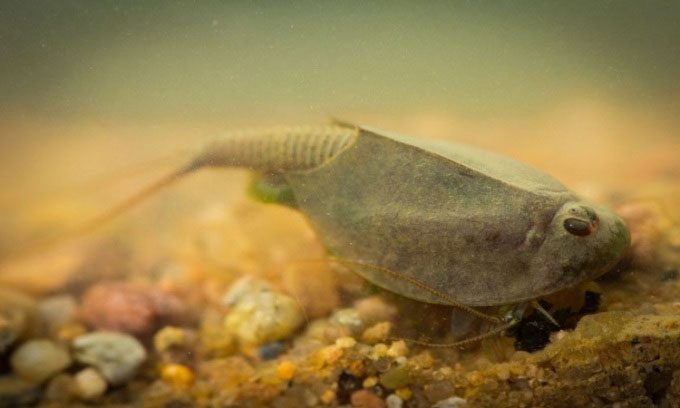Tadpole shrimp, coelacanths, and horseshoe crabs are often referred to as “living fossils” due to their remarkable lack of evolutionary change over hundreds of millions of years.

Tadpole shrimp swimming in a pond. (Photo: Marián Polák)
The Guinness World Records awarded the title of “the oldest living organism” to the tadpole shrimp (Triops cancriformis) in November 2010. Fossils indicate that this shrimp-like crustacean has existed since the Triassic period (approximately 201.3 to 251.9 million years ago), as reported by Live Science on December 12.
Tadpole shrimp have a shovel-shaped body, perfectly designed for burrowing in the bottoms of temporary water pools where they reside. This body structure has remained so effective that it has not changed for hundreds of millions of years. However, DNA research published in 2010 revealed that tadpole shrimp have never stopped evolving beneath their armored shells, leading to differences among species that are not always detectable by the human eye.
For instance, the tadpole shrimp T. cancriformis is merely a descendant of Triassic ancestors and is no more than 25 million years old, according to a 2013 study published in the journal PeerJ. Another study in 2012 in the journal PLOS One suggested that they might be only 2.6 million years old.
Some species still alive today also seem to have remained unchanged for millions of years and may compete for the title of the longest-living animals on Earth with the tadpole shrimp. Perhaps the most famous among them is the group of deep-sea fish known as coelacanths (Coelacanth). Fossils of coelacanths were first discovered in the 19th century, and they were believed to have gone extinct at the end of the Cretaceous period around 66 million years ago. However, in 1938, fishermen caught a living coelacanth off the coast of South Africa. This ancient fish is estimated to be over 400 million years old.
Modern coelacanths in the ocean are not the same as the extinct fossilized coelacanths. A 2010 study published in the journal Marine Biology revealed that living species appeared within the last 20 to 30 million years. The same is true for horseshoe crabs, which have existed for about 480 million years. A study published in 2012 in the journal Molecular Phylogenetics and Evolution found that the oldest living group of Asian horseshoe crabs, known as Tachypleus, only appeared around 25 million years ago, despite resembling fossils that are hundreds of millions of years old.
Biologists have yet to fully decipher the evolutionary history of all living animals. However, the tadpole shrimp, coelacanths, and horseshoe crabs reveal that even the most seemingly stable organisms undergo change. Fossil research indicates that species exist for a period of 500,000 to 3 million years before becoming extinct or being replaced by a descendant species.





















































